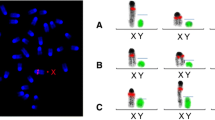Abstract
The Sry-related gene Sox9 has been proposed as the gene responsible for the mouse skeletal mutant Tail-short (Ts), on the basis of its expression in skeletogenic mesenchymal condensations in the mouse embryo and its chromosomal location in the region of Ts on distal Chromosome (Chr) 11. We present here detailed mapping of Ts locus relative to the Sox9, using an inter-subspecific cross. Among 521 backcross progeny, 16 recombinants were detected between Sox9 and Ts, suggesting a separation of 3.5 ± 0.01 cM, and excluding Sox9 as a candidate for Ts. A further nine recombinants were detected between Ts and the poly-comb-like gene M33, suggesting that these loci are separated by 1.8 ± 0.011 cM. Six microsatellite markers were co-localized to the Ts locus, providing reagents for positional cloning of Ts.
Similar content being viewed by others
References
Andrew, N.C., Erdjument-Bromage, H., Davidson, M.B., Tempst, P., Orkin, S.H. (1993). Erythroid transcription factor NF-E2 is a haematopoietic-specific basic-leucine zipper protein. Nature 362, 722–728.
Bonhomme, F., Guénet, J.-L. (1989). The wild house mouse and its relatives. In Genetic Variants and Strains of the Laboratory Mouse, 2nd ed., M.F. Lyon, A.G. Searle, eds., (New York, N.Y.: Oxford University Press), pp. 649–662.
Brotherton, T.W., Chui, D.H.K., McFarland, E.C., Russell, E.S. (1979). Fetal erythropoeisis and haemoglobin ontogeny in Tail-short (Ts/+) mutant mice. Blood 54, 673–683.
Deol, M.S. (1961). Genetical studies on the skeleton of the mouse XXVIII. Tail-short. Proc. Roy. Soc. Lond. B. 155, 78–95.
Foster, J.W., Dominguez-Steglich, M.A., Guioli, S., Kwok, C, Weiler, P.A., Weissenbach, J., Young, I.D., Mansour, S., Goodfellow, P.N., Brook, J.D., Schafer, A.J. (1994). Mutations in an Sry-related gene cause campomelia dysplasia and autosomal sex reversal. Nature 372, 525–530.
Gecz, J., Gaunt, S.J., Passage, E., Burton, R.B., Cudrey, C., Pearce, J.J.H., Fontes, M. (1995). Assignment of a Polycomb-like chromobox gene (CBX2) to human chromosome 17q25. Genomics 26, 130–133.
Houston, C.S., Opitz, J.M., Spranger, J.W., Macpherson, R.I., Reed, M.H., Gilbert, E.F., Herrmann, J., Schinzel, A. (1983). The campomelic syndrome: review, report of 17 cases, and follow-up on the currently 17-year-old boy first reported by Maroteaux et al. in 1971. Am. J. Med. Genet. 15, 3–28.
Jeske, Y.W.A., Bowles, J., Greenfield, A., Koopman, P. (1995). Expression of a linear Sry transcript in the mouse genital ridge. Nature Genet. 10, 480–482.
Koopman, P., Munsterberg, A., Capel, B., Vivian, N., Lovell-badge, R. (1990). Expression of a candidate sex-determining gene during mouse testis differentiation. Nature 348, 450–452.
Lee, F.A., Issacs, H., Strauss, J. (1972). The ‘camptomelic’ syndrome. Short life-span dwarfism with respiratory distress, hypotonia, peculiar facies, and multiple skeletal and cartilaginous deformities. Am. J. Dis. Child. 124, 485–496.
Manly, K. (1993). A Macintosh program for storage and analysis of experimental genetic mapping data. Mamm. Genome 4, 301–314.
McKie, J., Johnstone, K., Mattei, M.G., Scrambler, P. (1995). Cloning and mapping of murine Nfe211. Genomics 35, 716–719.
McKie, J., Scambler, P.J. (1996) The Nfe 2ll gene maps to distal mouse Chromosome 11. Mamm Genome 7, 89–90.
Morgan, W.C. (1950). A new Tail-short mutation in the mouse. J. Hered. 41, 208–215.
Moriwaki, K. (1994). Wild mouse from a geneticist’s viewpoint. In Genetics in Wild Mice, K. Moriwaki, T. Shiroishi, H. Yonekawa, eds. (Japan Scientific Society Press/Karger), pp. xiii-xxv.
OMIM online database. Johns Hopkins University, Baltimore, Md. MIM number 114290. Date last edited: July 21, 1995.
Paterson, H.F. (1980). In vivo and in vitro studies on the early embryonic lethal Tail-short (Ts) in the mouse. J. Exp. Zool. 211, 247–256.
Pearce, J.J.H., Singh, P.B., Gaunt, S.J. (1992). The mouse has a Polycomb-like chromobox gene. Development 114, 921–929.
Sambrook, J., Fritsch, E.F., Maniatis, T. (1989). Molecular Cloning: A Laboratory Manual., 2nd ed. (Cold Spring Harbor, NY: Cold Spring Harbor Laboratory Press).
Singh, P.B., Ross Miller, J., Pearce, J.J.H., Kothary, R., Burton, R.D., Paro, R., James, T.C., Gaunt, S.J. (1991). A sequence motif found in a Drosophila heterochromatin protein is conserved in animals and plants. Nucleic Acids Res. 19, 789–794.
Stein, L.J., Mackensen, J.A. (1957). Abnormal development of the thoracic skeleton in mice homozygous for looped-tail. Am. J. Anat. 100, 205–223.
Suda, T., Oyanagi, M., Wakana, S., Takahashi, Y., Kanda, H., Yonekawa, H., Miyashita, N., Shiroishi, T., Moriwaki, K., Kominami, R. (1994). Novel mouse microsatellites: primer sequences and chromosomal location. DNA Res. 1, 169–174.
Theiler, K., Gluecksohn-Waelsch, S. (1956). The morphological effects and the development of the fused mutation in the mouse. Anat. Rec. 125, 83–104.
Tommerup, N., Schempp, W., Mienecke, P., Pedersen, S., Bolund, L., Brandt, C, Goodpasture, C, Guldberg, P., Held, K.R., Reinwein, H., Saaugstad, O.D., Scherer, G., Skjeldal, O., Toder, R., Westvik, J., van der Hagen, C.B., Wolf, U. (1993). Assignment of an autosomal sex reversal locus (SRA1) and campomelic dysplasia (CMPD1) to 17q24.3-q25.1. Nature Genet. 4, 170–174.
Wagner, T., Wirth, J., Meyer, J., Zabel, B., Held, M., Zimmer, J., Pasantes, J., Bricarelli, F.D., Keutel, J., Hustert, E., Wolf, U., Tommerup, N., Schempp, W., Scherer, G. (1994). Autosomal sex reversal and campomelic dysplasia are caused by mutations in and around the SRY-related gene Sox9. Cell 79, 1111–1120.
Wright, E., Hargrave, M.R., Christiansen, J., Cooper, L., Kun, J., Evans, T., Gangadharan, U., Greenfield, A., Koopman, P. (1995). The Sry-related gene Sox9 is expressed during chondrogenesis in mouse embryos. Nature Genet. 9, 15–20.
Author information
Authors and Affiliations
Rights and permissions
About this article
Cite this article
Uchida, K., Koopman, P., Mita, A. et al. Exclusion of Sox9 as a candidate for the mouse mutant Tail-short. Mammalian Genome 7, 481–485 (1996). https://doi.org/10.1007/s003359900147
Received:
Accepted:
Issue Date:
DOI: https://doi.org/10.1007/s003359900147




